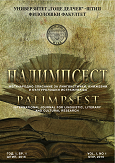DIALOGUE THROUGH BALLADS: CONSTRUCTING MEANING IN BALKAN ORAL TRADITION
DOI:
https://doi.org/10.46763/PALIM24918159kAbstract
This research examines the role of ballads as powerful instruments for dialogue and meaning-making across various cultural contexts. Ballads are viewed as dynamic narrative forms that serve a dual purpose: preserving cultural heritage and facilitating the transmission of universal values such as love, sacrifice, and heroism. By employing a comparative literary approach, this study highlights how these recurring themes in ballads act as bridges for cross-cultural empathy, promoting mutual understanding across different societies. The analysis also emphasizes the ability of ballads to transcend geographical and cultural boundaries, uniting diverse populations through shared emotional and experiential connections. The research findings suggest that ballads foster a collective human experience and function as effective mediums for intercultural communication. Drawing on theoretical frameworks from anthropology and cultural studies, the paper argues that integrating ballads into educational and intercultural initiatives could significantly enhance mutual respect and understanding among diverse groups. Such integration would provide a powerful tool for promoting cultural exchange and fostering deeper connections between individuals and communities from various backgrounds.
Keywords: ballads; intercultural communication; narrative analysis; cultural heritage; universal themes; dialogue.


